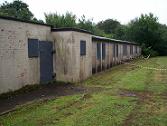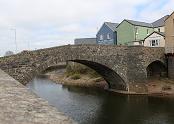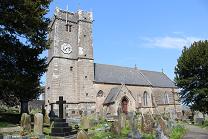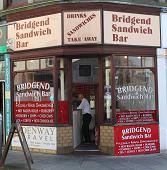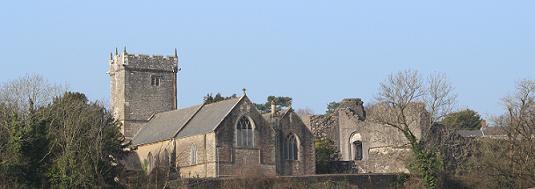 Bridgend
the town by the river
Bridgend
the town by the river
Island Farm
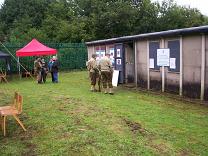

 Welcome to Island Farm
a Prisoner of War Camp known as
Camp 198 which lies on the outskirts of the town of Bridgend in South
Wales. The camp held up to 2000 prisoners, mainly German and some Italian,
and was the scene of the largest escape ever attempt by German Prisoners Of
War in Britain during World War II.
Welcome to Island Farm
a Prisoner of War Camp known as
Camp 198 which lies on the outskirts of the town of Bridgend in South
Wales. The camp held up to 2000 prisoners, mainly German and some Italian,
and was the scene of the largest escape ever attempt by German Prisoners Of
War in Britain during World War II.
The construction of the camp that became known as the Island Farm Camp was
started in 1936 and
was originally built to house the workers employed at the munitions factory
in Bridgend ROF 53. But they preferred to travel, some up to 30 miles a day
rather than stay in the camps dull and dismal conditions. The camp remained
empty until 1943, until the American troops arrived and were housed there prior to the
invasion of France.
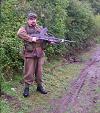
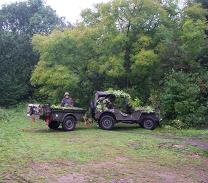

After the successful invasion the authorities had to find a camp for the large number
of prisoners captured in Europe. Island Farm was empty and the prefabricated
concrete huts were surrounded by open fields which made it an ideal place,
some conversion work had to be carried out prior to the arrival of the
prisoners with barbed wire fences being erected. The first batch of
prisoners that arrived was then put to work completing the conversion.
The camp known as Island Farm was re-designated as Camp 198 and housed
the German and some Italian troops. In 1944 all the enlisted prisoners were moved out, to
make way for German Officers, the first of these officer prisoners POWs arrived
in November 1944.

They soon started to plan an escape. Two tunnels were dug, but the first was
discovered in January 1945. The second tunnel went undetected and on the
night of 10 March 1945, about, 70 to 80 (the exact number was unknown) prisoners escaped through a tunnel
dug from Hut 9, the tunnel was about 60 feet long and went well past the
perimeter fence.
The techniques used by the inmates were ingenious. Excavating the tunnel was
not the easiest of tasks, as the heavy Welsh clay soil which the camp was built upon was
difficult to excavate with the cans, knives and tins they had retrieved from the
camp canteen but they were used as digging
implements and put together to form an air pipe to the tunnel.
The soil was moved out of the tunnel on a makeshift skip and put into kit
bags. At first, prisoners carried the soil in their pockets to the long jump
pit or gardening plots. Others kneaded clay into small balls and dropped them
through a hole in a false wall they had constructed in an unused room in one
of the huts managing to conceal much of the soil.
To support the tunnel roof, oak benches were stolen from the camp canteen, a
ventilation pipeline was made from condensed milk tins and the air was
pumped through by a hand operated fan. The tunnel had its own electric
lights that were tapped off the mains supply. And the Noise was concealed by
chorus singing.
The Great Escape
The escapers were divided into small groups, each of which was equipped with
food, map and homemade compass, they also had identity papers that were produced in
the camp. All these preparations required tremendous organization, but to
this day it is not known who actually organized the escape. Escaperís were
split into small groups, each escaperís identity was known only to the
others in his small group, protecting them against betrayal and the
authoritiesí knowledge of the full extent of the escape.
All but 3 were recaptured, although a few were captured close to the camp,
others were spread much further afield, a doctorís car had been stolen and a
few of the prisoners reached Birmingham and even Southampton, over 150 miles, a
very long way in 1945.
Just three weeks after the escape, on 31 March 1945, all 1,600 officers were
transferred out from Island Farm. It was then re-designated Special Camp 11
and was made ready to receive senior German officers. In all there were 160
officers holding the rank of general, admiral, or field marshal, including a
number of Hitler's closest advisers. Many of them had been captured in
France and were held awaiting a trial at Nuremberg.
Near the end of the war it became known as Special Camp XI. The list
of former inmates includes many senior SS military leaders, who were
awaiting extradition to the Nuremberg trials.
A few names of the POWs
Field Marshal Gerd von Rundstedt, commander in chief of the German armies in
the campaign against France in 1940
Field Marshal Paul Ludwig Ewald von Kleist, who was involved in the Battle
of Paris and was in charge of Army Group A from 1942 until 1944.
Field Marshal Erich von Manstein, who established the operation plans for
Hitler's successful campaign in the west and commanded the Eleventh Army,
which conquered the Crimea and Sevastopol on the eastern front.
Field Marshal Walther von Brauchitsch, who was named commander in chief of
the German army by Hitler in 1938 and who was instrumental in the planning
and execution of attacks on Poland, the Netherlands, Belgium, France,
Yugoslavia, Greece, and the Soviet Union.
Generaloberst
Gotthard Heinrici, commander of Army Group Vistula, who defended Berlin
against three Red armies in the last battle of World War II.
Generaloberst
Heinrich von Vietinghoff, Supreme Commander of the 10th German Army in
Italy, 1943 to 1945, which the Germans referred to as the South western
Front.
Island Farm Camp closed in 1948, when the last prisoners were returned to
Germany.
Today all that remains of Island Farm is
Hut 9.
A Love story of One of the Prisoners and a local Lady.
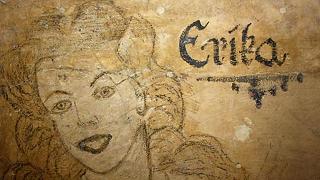
A picture of his sweet heart drawn on the
hut wall.
One of the Prisoners of Island Farm didnít return home to Germany after the
war was over he married a Lady from Aberkenfig and even played football for
Tondu Robins.
His name was Helmut Gunter Gutler , he wasnít a prisoner awaiting trial. In
fact he may have been in the navy. However there is a drawing on the hut
wall of a young lady named Erika. And the story goes that Erika the
Lady from Aberkenfig
married, Helmut
Gunter Gutler and they settled in Sarn after the war ended. He was a very
good footballer who played for Bayern Munich and Germany before the war, He
fitted in well with the Tondu Robins and when they played, the opposition new
they were in for a tough match.
Utube video Here
Share with your friends on Facebook or Twitter. Just Click the link below.
 Facebook
Facebook
 Twitter
Return to Main
Bridgend History Page
Advertisements
Twitter
Return to Main
Bridgend History Page
Advertisements

42 Dunraven Place, Bridgend
Contact: Mike 07840 287 383
web site here
Copyright BridgendPPF.com 2017




 Bridgend
the town by the river
Bridgend
the town by the river 












